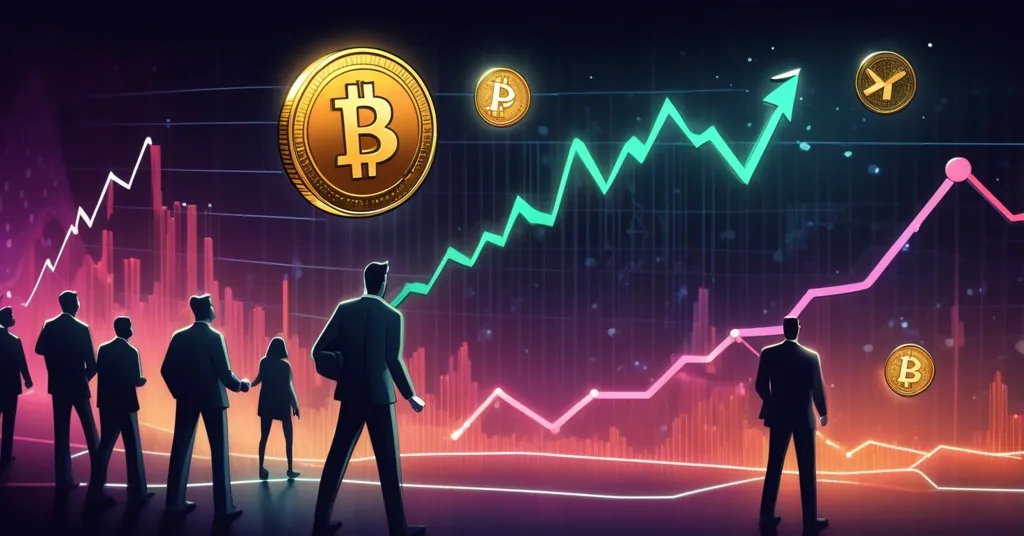XRP, Stellar, Chainlink Surge: Altcoin Rally or Dangerous Hype Bubble?

XRP, Stellar, Chainlink Price Surge: Crypto Market Rally or Hype Overload?
Bitcoin’s recent rally has lit a fire under the altcoin market, with Ripple (XRP), Stellar (XLM), and Chainlink (LINK) posting eye-popping gains and fueling wild price predictions. Add to that a new presale project, Bitcoin Hyper ($HYPER), dangling promises of a 10x surge, and the crypto space is buzzing with excitement. But let’s not get swept away by the noise—here’s a no-nonsense breakdown of what’s driving this momentum, the fundamentals behind these projects, and the risks that could send it all crashing down.
- Bitcoin’s Influence: Reports of Bitcoin nearing historic highs fuel altcoin momentum, with XRP boasting a 441% yearly gain, XLM spiking 13% overnight, and LINK jumping 12%.
- Regulatory Hope: The SEC’s Project Crypto could bring clarity to digital assets, potentially boosting investor confidence across the board.
- Speculative Traps: Overblown price targets and unproven projects like Bitcoin Hyper demand a heavy dose of skepticism amidst the frenzy.
Why This Rally Matters
The crypto market is no stranger to wild swings, and right now, we’re in the middle of a surge that’s turning heads. Bitcoin, often the bellwether for the entire space, has reportedly flirted with a peak of $122,838 last month—or so some sources claim. Truth be told, most historical data pegs its all-time high closer to $69,000 from November 2021, with recent rallies pushing past $60,000 stoking optimism. Whether inflated or not, this sentiment has triggered a classic capital rotation: investors moving profits from Bitcoin into riskier altcoins chasing higher returns. If you’re new to this game, altcoins are cryptocurrencies other than Bitcoin, often built for niche purposes like fast payments or data sharing—and they can skyrocket when Bitcoin shines, but they crash harder too.
Post-halving bull runs, like the one speculated after Bitcoin’s April 2024 halving, tend to amplify this effect. Historically, these cycles—think 2017 or 2021—pump up smaller assets as FOMO kicks in. But let’s not forget the aftermath: brutal corrections, rug pulls, and shattered dreams. XRP’s collapse after its 2018 peak of $3.40 is a prime example. So while the numbers for XRP, Stellar, and Chainlink look tantalizing, and projects like Bitcoin Hyper promise the moon, we’re here to cut through the hype with cold, hard facts and a bit of healthy doubt. Let’s dive into each player and see what’s real and what’s just hot air.
XRP’s Meteoric Rise: Utility or Bubble?
Ripple’s XRP has been stealing the spotlight, reportedly hitting a record high of $3.65 on July 18, surpassing its 2018 peak. Though current trading prices hover between $2.80 and $3.33 depending on the source, the token’s 441% gain over the past 12 months absolutely crushes Bitcoin’s 104% climb. For context, its Relative Strength Index (RSI)—a metric gauging if an asset is overbought or oversold—sits at 62, signaling strong buying interest without yet hitting “danger zone” levels. Chart-watchers also point to a bullish flag pattern, a technical formation suggesting the price could keep climbing, possibly to $4 if momentum holds, as detailed in this analysis of XRP’s price surge.
What’s driving this beyond squiggly lines on a graph? XRP’s real edge is its utility. Designed for cross-border payments, it offers near-instant settlement times and transaction costs so low they’re practically negligible. Banks and financial institutions have taken notice, with partnerships spanning the globe. The United Nations has even endorsed XRP’s potential for intermediary-free global payment networks. A 2023 U.S. court ruling declaring XRP isn’t a security in secondary markets further cleared the regulatory fog, making it more attractive to institutional players. These fundamentals give XRP legs that many altcoins lack, and you can learn more about its background on XRP’s overview page.
But hold your horses—don’t let $10 price predictions floating around blind you to reality. Hitting $10 would require a 250% surge from current levels and push XRP’s market cap to a staggering $590 billion with its 59 billion token supply. That’s more than many top global companies combined, and it’s pure fantasy without near-total banking adoption. Profit-taking by early investors could easily stall any rally, and broader market downturns remain a constant threat. XRP’s got promise, but it’s not a golden ticket. For deeper insights, check this report on XRP’s price and regulatory impacts.
Stellar’s Quiet Strength in Cross-Border Payments
Often overshadowed by XRP, Stellar (XLM) is no slouch, holding a market cap over $14.5 billion and ranking as the 14th-largest cryptocurrency. A recent 13% overnight spike pushed its price to $0.446, though it’s still a far cry from its 2018 high of $0.8756. Like XRP, Stellar laser-focuses on cross-border transactions, aiming to make sending money globally as cheap and easy as sending an email. It runs on its unique Stellar Consensus Protocol, sidestepping the energy-guzzling Proof-of-Work model used by Bitcoin, and has been grinding since 2014. Community discussions on platforms like Reddit highlight Stellar’s role in cross-border payments.
What sets Stellar apart is its mission to serve the underserved—think remittances in regions like Africa or Asia where predatory fees from traditional systems bleed people dry. Partnerships with organizations in developing markets and UN backing for affordable global payments underscore its real-world impact. If it breaks resistance at $0.50, some see a rally to $0.80 by October. That’s not unreasonable if broader altcoin momentum continues, but it’s hardly guaranteed.
Here’s the rub: Stellar lacks the legal clarity XRP gained, and its price action often lags behind flashier tokens. Without a major catalyst—say, a blockbuster partnership or regulatory win—hitting that $0.80 mark might be more wishful thinking than reality. Still, its longevity and focus on empowering the unbanked align squarely with the ethos of decentralization, making it a project worth watching beyond mere price speculation.
Chainlink: Bridging Blockchains to Reality
Chainlink (LINK) is carving a different path, with a 12% overnight jump to $19.32 and an RSI of 64, pointing to solid buying pressure. Some speculate a push to $30 if it clears resistance at $25, but LINK’s story isn’t just about price—it’s about solving a critical problem. As a decentralized oracle network, Chainlink connects blockchains to real-world data—think price feeds, weather stats, or election results—that smart contracts need to function. Without oracles, blockchains are blind to the outside world, and LINK fills that gap. For more on its significance, explore discussions about Chainlink’s role in decentralized oracles.
Its partnership with SWIFT, the backbone of global financial messaging, to integrate tokenized assets shows how Chainlink ties traditional finance to decentralized systems. This interoperability is invaluable in a fragmented blockchain landscape, positioning LINK as a foundational piece for the future of DeFi and beyond. With hundreds of integrations across protocols, its utility isn’t just hype—it’s measurable. But let’s not ignore risks: reliance on oracles introduces vulnerabilities like data manipulation if sources are compromised, and competition from other oracle solutions could eat into its dominance. A $30 price tag isn’t a given if adoption stalls or the market turns sour.
Bitcoin Hyper: Presale Promise or Pipe Dream?
Now, let’s talk about Bitcoin Hyper ($HYPER), a presale project raising eyebrows with $7.7 million already in the bag and bold claims of a 10x surge post-launch. For the uninitiated, it’s pitched as a Layer 2 protocol for Bitcoin—think of Layer 2 as an add-on that processes transactions off Bitcoin’s main chain to boost speed and cut fees, while still leveraging Bitcoin’s security. Bitcoin Hyper integrates the Solana Virtual Machine (SVM) for high throughput and low gas costs, aiming to “unleash Bitcoin’s true power” for payments, DeFi, and even meme coins. Learn more about its fundraising success in this report on Bitcoin Hyper’s presale details.
On paper, it sounds revolutionary. Bitcoin’s scalability issues—slow transactions and fees that spike during congestion—are real pain points, and solutions like this could open new use cases. Audits from firms like Coinsult and SpyWolf are cited as proof of legitimacy. But let’s be blunt: untested projects promising the moon often end up as rug pulls or ghost towns. If every presale claiming 10x returns delivered, we’d all be billionaires—spoiler, we’re not. Bitcoin Hyper faces stiff competition from established Layer 2s like Lightning Network, which focuses on payments, and Rootstock, which enables smart contracts. Plus, Solana’s own centralization critiques raise questions about whether SVM is the right fit for Bitcoin’s ethos. Until we see hard performance data post-launch, this is a gamble—don’t bet the farm. For a deeper dive into its potential and pitfalls, check this analysis of Bitcoin Hyper’s presale risks.
Regulatory Winds: A Game-Changer or False Hope?
Beyond individual projects, a potential regulatory shift in the U.S. is adding fuel to market optimism. The SEC’s Project Crypto, a new initiative under Chairman Atkins, seeks to modernize securities rules for digital assets. This could mean clearer classifications—separating tokens like XRP or LINK from murky “security” labels—better DeFi integration, and even an “innovation exemption” for cutting-edge models. For XRP, already bolstered by legal wins, this is icing on the cake. For LINK, tied to TradFi partnerships, and even Stellar, clarity could unlock institutional capital. Stay updated on this development with this overview of SEC’s Project Crypto initiative.
Chairman Atkins has pushed for balancing innovation with oversight, instructing SEC staff to use interpretive relief to avoid stifling entrepreneurship. But before you pop the champagne, remember that formal rulemakings are still pending. Traditional regulators and congressional hawks might resist, citing money laundering fears or loss of control, potentially dragging delays into 2025. Optimism is warranted for projects with strong fundamentals, but patience is non-negotiable—don’t bank on overnight miracles.
The Dark Side of Crypto Mania
Let’s address the elephant in the room: speculative price predictions are often pure garbage. XRP to $10, LINK to $50, Bitcoin Hyper to the stars—these clickbait forecasts are designed to pump bags, not inform. Crypto is a volatile beast; boom-bust cycles are baked into its DNA. Sure, altcoins like TRON, Solana, and even meme coins with absurd names like FartCoin have hit record highs over the past year. But for every jackpot, countless scams and dead projects litter the graveyard. If you’re diving in based on RSI or chart patterns alone, you’re rolling dice, not investing. Fundamentals—use case, adoption, tech—matter more, and even those can’t shield you from a market dump or a black swan event. For a broader look at speculative trends, see this update on crypto price predictions for XRP, Stellar, and Chainlink.
As someone who cheers for decentralization, I’m thrilled to see Bitcoin’s strength inspire innovation across XRP’s payment rails, Stellar’s access mission, Chainlink’s data bridges, and even long-shot bets like Bitcoin Hyper. This is the financial revolution—disrupting gatekeepers and empowering users. But as a realist with a Bitcoin maximalist streak, I’ve got to call out the nonsense. Unchecked mania and shady claims are the underbelly of this space, preying on FOMO-driven newcomers. Bitcoin purists might argue altcoins distract from BTC’s core as digital gold, and I feel that—nothing matches Bitcoin’s security and purity. Yet, these niche players solve problems Bitcoin wasn’t built to tackle, enriching the ecosystem. The trick is separating utility from feverish speculation.
Key Takeaways and Questions to Ponder
- What’s fueling the current altcoin surge?
Bitcoin’s reported rally near historic highs has sparked capital rotation into altcoins like XRP, Stellar, and Chainlink, with impressive yearly gains and bullish technical signals driving interest. - Why is XRP a standout for potential growth?
XRP’s 441% yearly surge, institutional support, UN endorsements, and U.S. legal clarity bolster its case for cross-border payments, though targets like $10 remain far-fetched without massive adoption. - How does Stellar (XLM) carve its niche?
Stellar mirrors XRP’s payment focus with a $14.5 billion market cap, targeting the underserved with UN backing, and could hit $0.80 if resistance breaks, though it lacks XRP’s regulatory edge. - What makes Chainlink (LINK) indispensable?
LINK’s decentralized oracle network bridges blockchains to real-world data, vital for smart contracts, with SWIFT partnerships fueling utility—$30 is possible, but not without risks like data vulnerabilities. - Is Bitcoin Hyper ($HYPER) worth the presale hype?
Raising $7.7 million with promises of Bitcoin scalability via Solana VM sounds enticing, but as an unproven project in a crowded Layer 2 field, it’s a high-risk bet until post-launch results emerge. - Can the SEC’s Project Crypto sustain market momentum?
The initiative offers hope for clearer digital asset rules, potentially lifting tokens like XRP and LINK, but pending formalizations and regulatory pushback mean it’s no immediate game-changer.
Navigating the Noise
The crypto market is electric right now, from XRP’s institutional clout to Chainlink’s tech prowess, Stellar’s quiet grit, and wildcards like Bitcoin Hyper reminding us why this space thrives on audacity. As we push for a decentralized future—full throttle on effective accelerationism—we can’t ignore the minefield. Volatility isn’t a bug; it’s a feature. Scams lurk at every turn, and no amount of technical analysis or regulatory optimism predicts the next crash. Stay sharp, question everything, and don’t let greed outpace reason. Are we on the cusp of a new financial dawn, or just inflating another bubble set to burst? The revolution is real, but surviving it demands more than blind hope.



